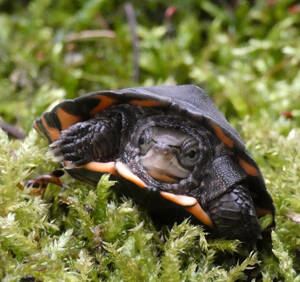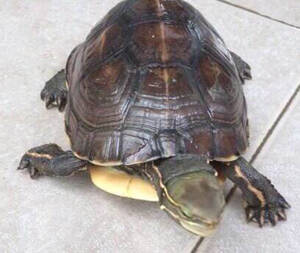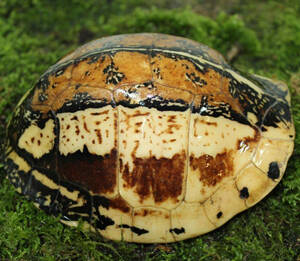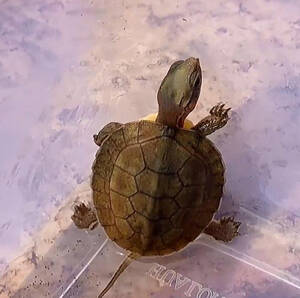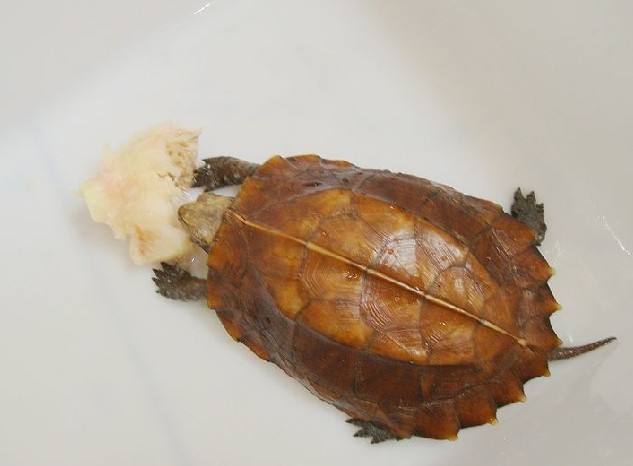Cuora trifasciata
IUCN
LCBasic Information
Scientific classification
- name:Cuora trifasciata
- Scientific Name:Cuora trifasciata,Chinese Three-striped Box Turtle,Golden coin turtle, golden head turtle, red edge turtle, red belly turtle, broken board turtle, Sichuan back turtle
- Outline:Testudines
- Family:Testudinidae B.turtle
Vital signs
- length:9-15cm
- Weight:700-1500g
- lifetime:About 50 years
Feature
It is an edible turtle species in southern China and is also commonly used as medicine by the people.
Distribution and Habitat
Distributed in China, Laos, and Vietnam. In China, it is distributed in Guangdong, Guangxi, Fujian, Hainan, etc. In Guangxi, it is mainly distributed in the counties of Nanning Chongzuo, Baise City, Qinzhou City, Fangchenggang City and other mountainous areas.
Appearance
The body is medium, with a total length of 94-157 mm. The head is of moderate size, with smooth skin on the back and fine cracks on the back. The snout slightly protrudes from the upper jaw, and the upper jaw is slightly hooked. The eyes are large and the eardrum is clear. The carapace is low and flat, oval, with a slightly concave or flat front edge and a rounded rear edge. The back has three ridges, with obvious ridges; the rear edge of the juvenile is slightly serrated, and the lateral ridges are weak. The cervical shield is long and narrow, rectangular or long strip. There are 5 vertebral shields, which are pentagonal or hexagonal, and the width is greater than the length. There are 4 pairs of costal shields, which are generally wider than the length. There are 12 pairs of marginal shields, all of which are rectangular, and each shield has a central wart and concentric patterns. The plastron is roughly the same length as the carapace, and is long oval, with a round front edge and a
Details
The three-striped box turtle is called Chinese Three-striped Box Turtle in English, and there are 2 subspecies.
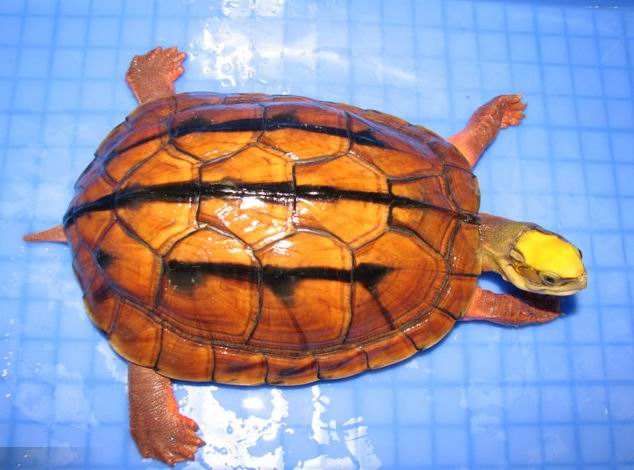
The two subspecies of the three-striped box turtle have similar diets and other biological characteristics. The Vietnamese subspecies is more adaptable and grows faster than the Hainan subspecies, and is more suitable for breeding in northern China. In terms of color, the lower jaw, neck, limbs and carapace of the Vietnamese subspecies are redder and brighter than those of the Hainan subspecies, but the waxy yellow color of the top of the head is not as bright as that of the Hainan subspecies. Among the Vietnamese subspecies, the "M"-shaped front end of the plastron is the representative species and is more popular. The choice of species depends mainly on personal preference.
The three-lined box turtle lives in mountain streams at an altitude of 50-400 meters in the south of Guangdong, China. During the day, it hides in caves or lush aquatic plants. It dives into the water when it is hot or frightened. It is active in the morning and evening. The three-lined box turtle likes places with plenty of sunshine, quiet environment and clear water. In nature, it mostly lives beside streams and rivers, and digs holes in the bushes by the water to make nests. It likes to live in groups, and sometimes there will be seven or eight turtles in a cave. The three-lined box turtle is an omnivorous turtle that mainly feeds on meat. In the water, it mostly preys on small fish, shrimps, tadpoles, etc. On the shore, they feed on various insects, snails, earthworms, etc., and sometimes they also eat fruits and vegetable leaves. They can be fed with fish, earthworms, clams or grains in artificial breeding.
Female turtles grow faster than male turtles, and the age of sexual maturity varies depending on the living environment and gender. Wild female turtles first reach sexual maturity at the age of 6-7 years old, weighing 1200-1500 grams, while male turtles reach sexual maturity at the age of 4-5 years old, weighing 700-1000 grams. Sexually mature three-lined box turtles usually mate in autumn or the spring of the second year, when the temperature is between 20-28℃ and the water temperature is above 20℃. Three-lined box turtles have no vocal organs. During the estrus season, male and female turtles each secrete a special smell to attract each other. Male turtles are active and have a hobby of chasing turtles of the opposite sex or the same sex. Especially during the mating season, they will bite the neck of the female turtle and climb on its carapace to mate. The egg-laying season is from May to September every year, with June and July being the peak season. Some turtles also lay eggs in the warm winter, but they cannot be fertilized. The three-lined box turtle often lays eggs at night, usually only once a year, but some turtles lay eggs twice. Each time, about 5-7 eggs are laid. The fertilized eggs are hatched with the help of the heat of sunlight. In nature, due to the changeable environment and many enemies, the hatching rate is often very low. Artificially bred three-lined box turtles mostly collect eggs in a centralized manner and hatch them uniformly. The general incubation environment temperature is 33-35℃, and the water content of the sediment is 12-16%. The incubation period is about 60 days, and the floating rate can reach more than 90%.
Due to environmental damage and excessive human use, wild three-lined box turtles are extremely rare. Except for some deep mountains and old forests, they have long been extinct in plains and hilly areas. The three-lined box turtle is the earliest box turtle species to be bred by humans. Artificial breeding technology has basically passed the test. However, there are still many technical difficulties to achieve successful large-scale breeding.
Because the three-lined box turtle has a high economic value, it is captured in large numbers, and wild resources have been severely damaged. In addition, the quality of the habitat has declined, and natural resources have been extremely depleted and urgently need protection.
Listed in the "IUCN Red List of Endangered Species" (IUCN 2000 ver 3.1) - Critically Endangered (CR).
Listed in the "Convention on International Trade in Endangered Species of Wild Fauna and Flora" (CITES) - Appendix II.
Listed in the "List of Nationally Protected Wildlife in China" - Level II.
Listed in the "Red List of Biodiversity in China - Vertebrate Volume" (Reptiles) - Critically Endangered (CR).
Protect wildlife and eliminate game.
Maintaining ecological balance is everyone's responsibility!



